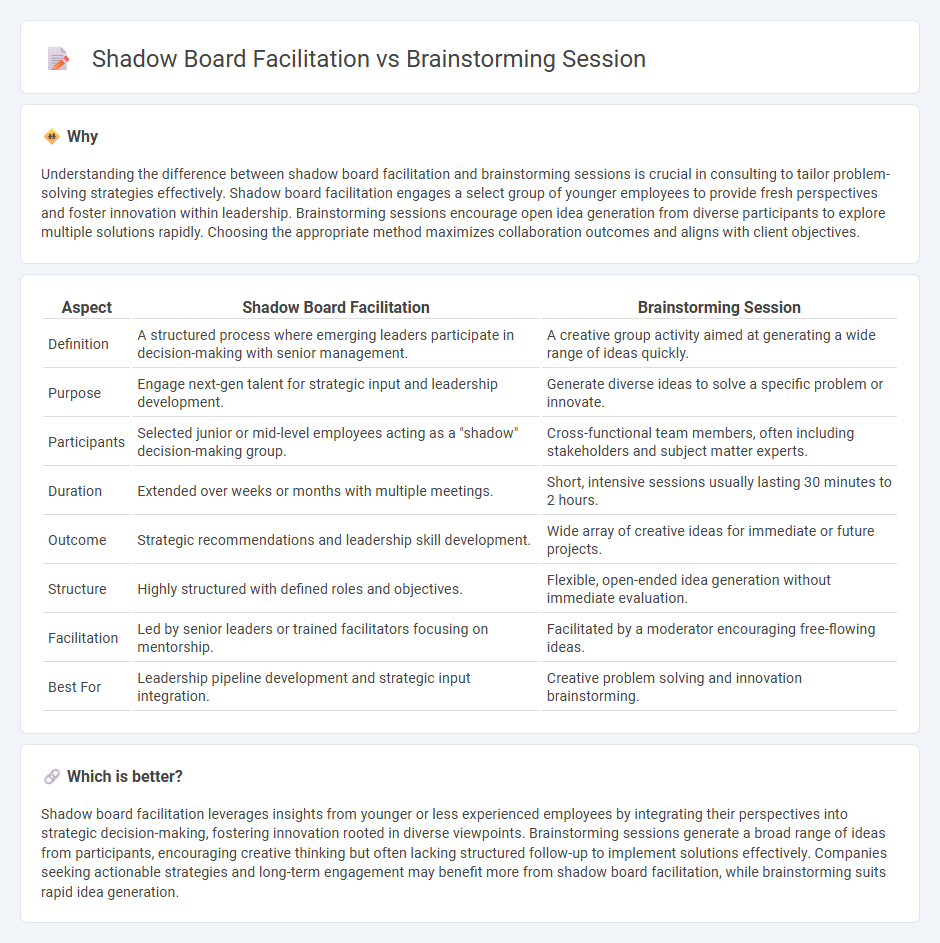
Shadow board facilitation enables emerging leaders to contribute strategic insights within a structured framework, fostering cross-generational collaboration and innovation. Brainstorming sessions encourage open-ended idea generation, promoting creativity and quick exploration of diverse perspectives. Discover how integrating both approaches can drive impactful decision-making and enhance organizational agility.
Why it is important
Understanding the difference between shadow board facilitation and brainstorming sessions is crucial in consulting to tailor problem-solving strategies effectively. Shadow board facilitation engages a select group of younger employees to provide fresh perspectives and foster innovation within leadership. Brainstorming sessions encourage open idea generation from diverse participants to explore multiple solutions rapidly. Choosing the appropriate method maximizes collaboration outcomes and aligns with client objectives.
Comparison Table
| Aspect | Shadow Board Facilitation | Brainstorming Session |
|---|---|---|
| Definition | A structured process where emerging leaders participate in decision-making with senior management. | A creative group activity aimed at generating a wide range of ideas quickly. |
| Purpose | Engage next-gen talent for strategic input and leadership development. | Generate diverse ideas to solve a specific problem or innovate. |
| Participants | Selected junior or mid-level employees acting as a "shadow" decision-making group. | Cross-functional team members, often including stakeholders and subject matter experts. |
| Duration | Extended over weeks or months with multiple meetings. | Short, intensive sessions usually lasting 30 minutes to 2 hours. |
| Outcome | Strategic recommendations and leadership skill development. | Wide array of creative ideas for immediate or future projects. |
| Structure | Highly structured with defined roles and objectives. | Flexible, open-ended idea generation without immediate evaluation. |
| Facilitation | Led by senior leaders or trained facilitators focusing on mentorship. | Facilitated by a moderator encouraging free-flowing ideas. |
| Best For | Leadership pipeline development and strategic input integration. | Creative problem solving and innovation brainstorming. |
Which is better?
Shadow board facilitation leverages insights from younger or less experienced employees by integrating their perspectives into strategic decision-making, fostering innovation rooted in diverse viewpoints. Brainstorming sessions generate a broad range of ideas from participants, encouraging creative thinking but often lacking structured follow-up to implement solutions effectively. Companies seeking actionable strategies and long-term engagement may benefit more from shadow board facilitation, while brainstorming suits rapid idea generation.
Connection
Shadow board facilitation and brainstorming sessions are connected through their focus on harnessing diverse perspectives to drive innovation and strategic decision-making within organizations. Shadow boards, composed of emerging leaders or younger employees, use brainstorming sessions to generate fresh ideas and challenge conventional thinking, fostering a culture of creativity and inclusion. This collaborative approach enhances problem-solving effectiveness by integrating cross-generational insights and promoting active participation.
Key Terms
**Brainstorming Session:**
Brainstorming sessions encourage collaborative idea generation by allowing participants to share diverse perspectives and foster creativity in a structured environment. Effective facilitation techniques include setting clear objectives, promoting equal participation, and using visual aids to capture and organize ideas. Explore proven strategies to maximize the impact of your brainstorming sessions for innovation and problem-solving.
Ideation
Brainstorming sessions generate diverse ideas through spontaneous group discussions, encouraging creative thinking without immediate judgment. Shadow board facilitation involves a young talent advisory group working closely with senior executives, focusing on strategic ideation and innovative solutions informed by fresh perspectives. Explore how each method drives ideation effectiveness within organizational innovation frameworks.
Divergent Thinking
Brainstorming sessions encourage divergent thinking by allowing participants to generate a wide variety of ideas without immediate judgment, fostering creativity and innovation. Shadow board facilitation harnesses diverse perspectives from younger or less experienced employees, promoting fresh insights and challenging established norms within an organization. Explore how each method uniquely amplifies divergent thinking to drive transformative solutions.
Source and External Links
Brainstorming Sessions: Agenda Template + Best Practices - A brainstorming session is an informal meeting focused on solving problems through four stages: preparation, idea generation, convergence, and action planning, with a structured agenda to guide participation and decide on actionable steps.
How to Conduct a Brainstorming Session - Effective brainstorming sessions involve defining a clear purpose, setting goals and expectations, and using collaborative tools to engage teams in creative thinking, making it a key method to evolve ideas and innovate together.
What is Brainstorming? Techniques and Methods - The core of brainstorming is to generate many ideas freely, following ground rules that foster creativity, capturing all input, discussing and voting on ideas, then turning the best ideas into actionable plans.
 dowidth.com
dowidth.com